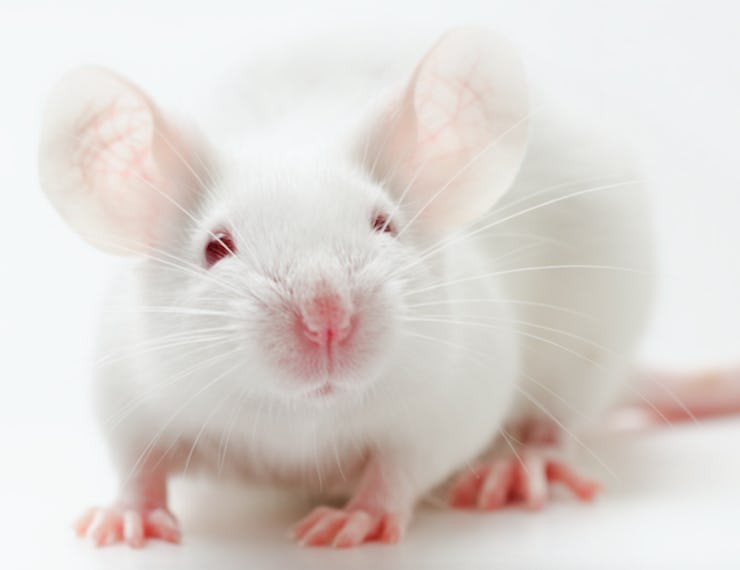4%

Genetically engineered mice are getting closer to humans
Scientists at the University of Buffalo have created mouse embryos that contain a strangely high amount of human cells.
by Emma BetuelHumans and rodents have more in common than you might think, despite the biological differences.
Because of new research, that space between us is starting to close.
In a study released this week in Science Advances, scientists report that they have engineered a mouse that's a bit human.
Scientists at the University of Buffalo have shown that it's possible to create mouse embryos that express very high levels of human cells. In one of the mouse embryos, four percent of the cells were actually human.
Those cells were present all over the nascent tissues in the mouse embryos, from retinal cells to red blood cells and liver cells.
Scientists use mice who express human cells all the time to study topics ranging from coronavirus vaccines to diet interventions. But those "humanized mice" actually don't have many human bits and pieces. Previous attempts at creating humanized mice resulted in animals with about 0.1 percent of their cells containing human material.
These newly reported mice are a cut above. The team hopes that the work could one day allow scientists to grow human organs or simply create mice that are closer to humans.
These would allow scientists could to create better experiments, which could lead to improved treatments, explains the study's corresponding author Jian Feng, a professor of physiology and biophysics.
"Further development of our technology could enable the generation of even larger quantities of specific types of mature human cells to allow us to create more effective mouse models to study diseases that gravely affect humans, such as malaria or COVID-19," Feng said.
This figure shows a large quantity of human cells (labeled green) in a 17-day old mouse embryo (labeled blue).
These embryos are particularly meaningful because of the medical promise they hold, but also because to they point us towards weird ethical territory.
In this new study, the original plan was to inject mouse blastocysts with human stem cells. These are types of cells that have the potential to become any kind of cell. The hope was that these cells would go on to thrive and become different human tissues as the blastocysts developed.
Stem cells tend to fall into two categories. There are naive stem cells, which can self-renew in perpetuity, and have the potential to become, essentially, anything. Then there are primed stem cells, which can also endlessly renew and become any tissue in Petri dishes.
Human stem cells often fall into the primed category. They don't always work in animal models, like mouse blastocysts, because they're in a different developmental stage.
The scientists hoped they could revert the primed stem cells to the naive stage so that they would develop alongside the very young mouse embryos.
They determined that by inhibiting a kinase (a type of enzyme) called mTor, they could reset these cells allow them to flourish and multiply alongside the young mouse cells while retaining their human signatures. The cells aren't perfect — the team argues they could be an intermediate state between the two — but they were close.
Then, once those naive stem cells were injected into 3.5-day-old mouse blastocysts, the team found that after 17 days, the embryos went on to produce far more human stem cells than expected — as many as 4 percent of the total cells in the blastocyst.
The cells also proliferated far quicker once they were reverted to the naive stage. Naive cells doubled, on average, in about 14.9 or 12.9 hours, depending on the cell type. The primed human cells doubled in about 35 hours or 33.5 hours, depending on the cell type.
Making mice more human – Feng says this rapid development likely occurred because the cells had been converted to that naive state, and because of the fact that the embryos were actually allowed to develop for 17 days.
That's longer than you would typically allow an animal embryo endowed with that many human cells to grow in a dish, The New Scientist reported.
The record was previously set by scientists in China who grew monkey embryos for 20 days.
The concern over letting these embryos develop longer comes from the idea that it starts to blur ethical lines. For instance, a 2014 Journal of Neuroscience study found that human stem cells in mouse brains proliferated rapidly. These mice were actually more intelligent as a result.
The fact that the mice were noticeably smarter raised concerns, John D. Loike, the director of special programs at the Center for Bioethics at Columbia University explains in The Scientist. These studies ask us to think about what attributes make humans different from animals. Loike asks: "When should such 'humanized' animals be afforded the rights that people currently enjoy?"
Of course, these mice embryos aren't even close to being human beings. Still, these findings push us just one step closer to mice that are closer to being like us in more ways than one.
Abstract: It has not been possible to generate naïve human pluripotent stem cells (hPSCs) that substantially contribute to mouse embryos. We found that a brief inhibition of mTOR with Torin1 converted hPSCs from primed to naïve pluripotency. The naïve hPSCs were maintained in the same condition as mouse embryonic stem cells and exhibited high clonogenicity, rapid proliferation, mitochondrial respiration, X chromosome reactivation, DNA hypomethylation, and transcriptomes sharing similarities to those of human blastocysts. When transferred to mouse blastocysts, naïve hPSCs generated 0.1 to 4% human cells, of all three germ layers, including large amounts of enucleated red blood cells, suggesting a marked acceleration of hPSC development in mouse embryos. Torin1 induced nuclear translocation of TFE3; TFE3 with mutated nuclear localization signal blocked the primed-to-naïve conversion. The generation of chimera-competent naïve hPSCs unifies some common features of naïve pluripotency in mammals and may enable applications such as human organ generation in animals.